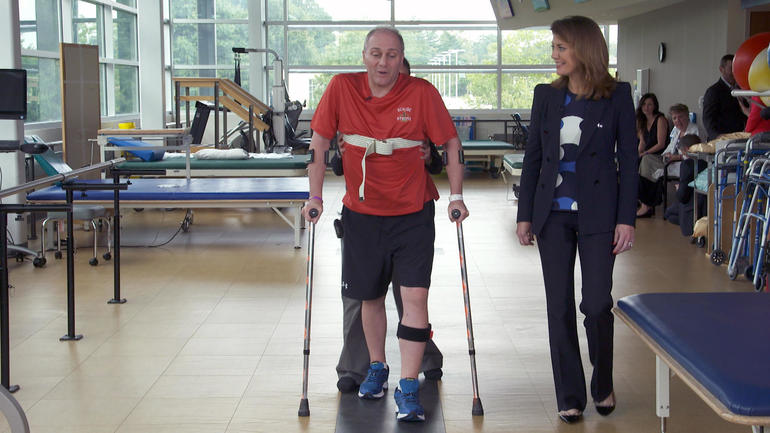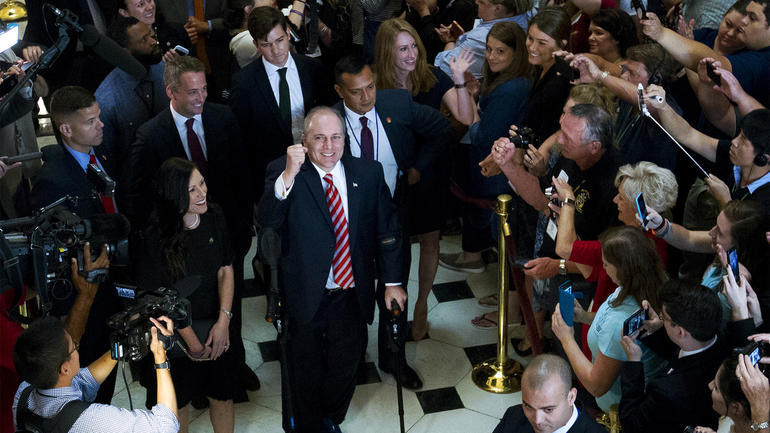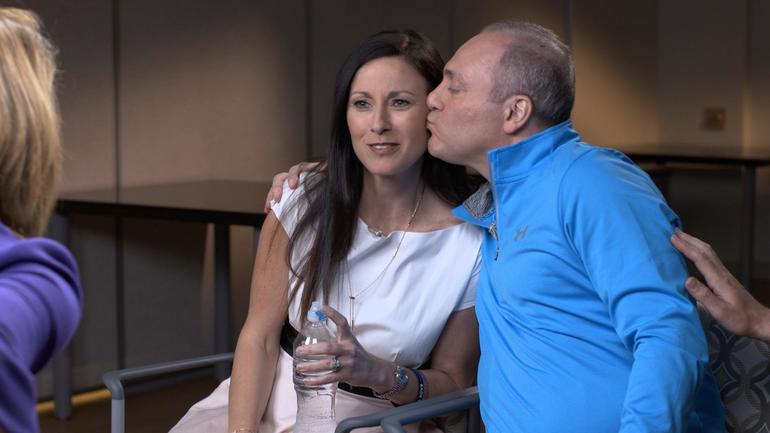Congressman Steve Scalise did something last year that’s rare in Washington. He brought Democrats and Republicans to their feet to cheer for the same thing. Members of both political parties welcomed him back to Congress with a rousing ovation, and with good reason.
On June 14, 2017, he was nearly killed when a gunman armed with a rifle and a 9mm handgun, ambushed the Republican congressional baseball team.
In his first interview after the shooting, joined by his wife Jennifer, he explained to us in vivid detail how he survived. It had not been widely known, until our story first aired last October, the extent of his injuries, what physical challenges were in his future, and just how close he came to death.

Rep. Steve Scalise and 60 Minutes correspondent Norah O’Donnell
CBS News
STEVE SCALISE: It’s a miracle. If you look at what happened that morning. You know, a gunman came out with a lot of artillery — you know, just hell bent on killing a lot of us. And we’re just out there playing baseball — sitting ducks. And he started firing away. If you would gave said at the end of this, the only person that would be dead would be the shooter, nobody would believe it.
“It’s a miracle. If you look at what happened that morning.” Rep. Steve Scalise
It was just after 7 a.m. at a ballpark in Alexandria, Virginia, when a team made up of Republican members of Congress went from shagging balls to dodging bullets.
Nat sound: [Gun shots] “Has that guy been shot? Is he OK?”

Rep. Steve Scalise and his wife, Jennifer, speak with 60 Minutes correspondent Norah O’Donnell.
CBS News
That guy was Congressman Steve Scalise. He’d been hit in the left hip with a bullet from a rifle. This cell phone video was among the first images of him that day. The last was him being wheeled on a gurney to a helicopter, clinging to life. He spent most of the next four days unconscious.
STEVE SCALISE: I found out later just how much damage was done internally. You know, I mean, my femur was shattered. The hip and pelvis had serious damage where the bullet went through and, you know, did some damage to areas that had to be shored up with steel plates and– then they did a phenomenal job of rebuilding, you know, kinda the, rebuilding Humpty Dumpty. I mean, there were, there was a lotta damage inside that had to get fixed.
NORAH O’DONNELL: They put you back together again.
STEVE SCALISE: They put me back together again.
NORAH O’DONNELL: You’re known as a man who loves politics and baseball. Have either of those things changed?

House Majority Whip Steve Scalise walks with his wife Jennifer, left, as he leaves the House chamber in the Capitol in Washington, Thu., Sept. 28, 2017.
AP
STEVE SCALISE: Not a bit. No, I love the job I have as a member of Congress representing southeast Louisiana. And I love being the House majority whip.
Nat sound: Congressman Steve Scalise: “This is morally wrong…”
As the majority whip, Steve Scalise ranks third in the Republican House leadership
Nat sound: Congressman Steve Scalise “This bill…”
And usually counts votes, not balls and strikes, unless he’s playing second base for the Republicans. And that’s where he was at practice the day before the Annual Congressional Baseball Game — one of the last bipartisan activities in a polarized Washington. Scalise was fielding balls when he heard what he thought was a tractor backfire and then he was on the ground.
STEVE SCALISE: I knew I was shot. Didn’t know how bad it was. You know, in a weird way, your body kind of goes numb. You know, as bad as the wounds were, and obviously I know now how severe it was. At the time, I guess my body had been shutting down a lot of the real pain. And I was just thinking about what was going on at the moment.
NORAH O’DONNELL: Did you see the shooter?
STEVE SCALISE: Never saw the shooter.
The shooter was 66 year-old James Hodgkinson. According to the FBI, he’d posted anti-Republican views on social media and had “a piece of paper that contained the names of six members of Congress.” We’ve learned they were all conservative Republicans. Scalise was not on the list but two of his teammates were.
NORAH O’DONNELL: Do you believe you were targeted as a Republican?
STEVE SCALISE: I think it was clear he had a political agenda if you want to even call it that. And it’s a sick twisted agenda. I don’t think he could have been in the right frame of mind. But it was clear what his intentions were.
NORAH O’DONNELL: When you were shot when you were on second base, you tried to crawl. Right?
STEVE SCALISE: Well, when I went down, you know, my first instinct was to try to get away from the gunfire. So I started crawling. And you know that’s when my arms gave out.
NORAH O’DONNELL: And then what did you do?
STEVE SCALISE: At that point I just went into prayer. And it gave me a calmness. It was a weird calmness while I’m hearing the gunfire. You know the first thing that came to mind. I prayed, “God, please don’t let my daughter have to walk up the aisle alone.” That was the first thing that came to mind.
NORAH O’DONNELL: That was the first thing?
STEVE SCALISE: Yeah. And obviously after that, I prayed that I could see my family again.
BRAD WENSTRUP: I could see the fire coming from the barrel of his rifle.
When the shooting started Congressman Brad Wenstrup of Ohio was near the batting cages. He had one eye on an injured Steve Scalise and the other on the shooter.
BRAD WENSTRUP: My fear was that he was gonna get more people. And– but I was also encouraged because we knew that we had somebody to return fire.
NORAH O’DONNELL: Because of Scalise’s detail– the Capitol police that were with him —
BRAD WENSTRUP: Exactly. Correct. Steve really took a bullet for all of us because if he’s not here, he doesn’t get hit. But if he’s not here, there might be 20 people laying out there.
NORAH O’DONNELL: Because he’s a member of the leadership he has security detail —
BRAD WENSTRUP: Correct.
STEVE SCALISE: It wasn’t just a shooter at that point. It was literally a shootout going back and forth. And I could hear it. You know, my– my– my, the sound was as clear as day. I knew what was happening. And it sounded like a lot of shots.
NORAH O’DONNELL: Your colleagues that were out there, they knew you were down, and they wanted to get to you. But the shots were still going on.
STEVE SCALISE: Yeah, while the shooting was going on– you know, Mike Conaway from Texas was playing first base, and he was able to get right behind the dugout. And he was the closest one to me, and I just kept remember him whispering, you know, “Stevie, don’t worry. We’re gonna get ya– we’re gonna get ya.” And he just kept whispering and it was– it was really calming. I could just sense that the other members were in the dugout waiting.
NORAH O’DONNELL: You remember that?
STEVE SCALISE: Till it was over. Yeah.
Nat sound: [Gun shots from the cell phone video]
The shootout lasted about 10 minutes and around 100 shots were exchanged with the gunman. Five people were injured. The shooting ended when the two Capitol police officers, joined by three Alexandria police, mortally wounded the shooter.
BRAD WENSTRUP: Once I saw him drop, that’s when I started running and making my way out to the outfield.
NORAH O’DONNELL: So you ran from behind the bathrooms here right through this gate to Congressman Scalise —
BRAD WENSTRUP: Right. Correct. Yes. So– and several people started running from the dugout, too, once they knew he was down.
Steve Scalise was bleeding to death, but his prospects for survival were about to improve. Brad Wenstrup isn’t just a congressman. He’s also a combat surgeon and a colonel in the Army Reserve.
NORAH O’DONNELL: As soon as the gunman was down, the cavalry came pretty quickly.
STEVE SCALISE: Yeah. It was– it– it just seemed like the true cavalry. I mean, you know, I heard the words, “Gunman down.” and Brad Wenstrup was, you know, immediately right there by my side, starting to actually administer care.
NORAH O’DONNELL: As an Iraq veteran you’ve dealt with a lot of trauma.
BRAD WENSTRUP: Sure.
NORAH O’DONNELL: When you saw the wound and you saw that it was essentially, what — through the hip and there was no exit wound how worried were you?
BRAD WENSTRUP: I was very worried actually. It reminded me of a case in Iraq where it didn’t have a good ending.
Transpelvic gunshot wounds are known for heavy internal bleeding that’s very difficult to stop. Congressman Wenstrup improvised a tourniquet out of a belt.
BRAD WENSTRUP: And put pressure on the wound. And then– later tourniquet came. We put on a regular tourniquet. I found a clotting bandage that we put into the dressing as well. And we waited for the helicopter basically.
BRAD WENSTRUP: Nice to see you.
RICK KRIMMER: Nice to see you, sir.
BRAD WENSTRUP: Under better circumstances.
RICK KRIMMER: Absolutely.
Dozens of first responders rushed to the scene. One of them was paramedic Rick Krimmer of the Alexandria fire department. He made the call to get Congressman Scalise onto the next available helicopter and helped load the congressman onboard.
STEVE SCALISE: You know, the only time I really started to worry was when they were getting ready to put me on the helicopter. And to me it seemed like forever. And I know it was probably just minutes. But I think I told some of the paramedics, “Don’t let me bleed out on this field.
BRAD WENSTRUP: I met the pilot of the helicopter later. He said, “I flew that bird like I stole it.”
A 7-minute flight away, across the Potomac River, the trauma team at Medstar Washington Hospital was ready.
Dr. Jack Sava led the team.
NORAH O’DONNELL: What condition was he in?
DR. JACK SAVA: Well, when he left the trauma unit, he did not have a blood pressure that anybody could find. So that’s obviously sort of hovering on the border between life and death.
To keep Scalise alive, two minutes after he arrived, they began something called a massive transfusion protocol. Dr. Sava says, it’s a method of delivering blood that’s been improved by hard lessons learned on the battlefields of Iraq and Afghanistan.
DR. JACK SAVA: The blood bank will just start sending blood in — in all the right combinations, the blood cells, the platelets, the plasma. It all comes in a cooler. And a cooler comes every 15 minutes till you call and say, “Stop.”
NORAH O’DONNELL: How many units of blood did Steve Scalise use in the first day?
DR. JACK SAVA: I think he got roughly 18 to 20 units of blood in the first day.
NORAH O’DONNELL: How much blood is that?
DR. JACK SAVA: That’s a lot. That’s more than you have in your body.
Doctors operated to stop the bleeding. Then employed imaging technology to find and seal the leaking blood vessels they couldn’t get to in normal surgery.
NORAH O’DONNELL: At what point did you think, “Okay he’s gonna make it”?
DR. JACK SAVA: I don’t know that I ever thought in those terms. I think that there was a point in the first operation, when we got some semblance of control, when I thought, “You know, maybe this guy’s got a shot.”
After 20 days in intensive care and nearly six weeks in the hospital he was transferred to an in-patient rehabilitation facility. There was plenty of work to do. Since the shooting, he’s undergone nine surgeries. To stop the bleeding, fight infections Dr. Sava says are common with these kinds of wounds and to repair his upper left leg, hip, and pelvis to help him get back on his feet.
Nat sound: Scalise: “It’s working well…”
He’d lost 50 pounds and at 51 years old needed to learn how to walk again.
Nat sound: Therapist: “Nice job.”
To start the process, he needed the help of a special machine to hold him up.
Nat sound: Scalise “It feels a lot better…”
When he attempted some steps on his own for the first time, his physical therapist, Meaghan Minzy, was there to make sure he didn’t fall.
NORAH O’DONNELL: You’re basically learning how to walk again?
STEVE SCALISE: You really are. You have to build the muscles back up. The muscles really deteriorated.
NORAH O’DONNELL: And-to be able to walk like this. It’s gotta be psychologically, like, a real milestone?

STEVE SCALISE: It feels real good. I mean, you can see the progress. And it’s something we’ve been trying to do for a long time and it’s nice to finally be there.
Jennifer Scalise thought so too.
NORAH O’DONNELL: Describe, like, what that meant to you to see your husband on his own walking.
JENNIFER SCALISE: It gave me hope.
NORAH O’DONNELL: Hope for what?
JENNIFER SCALISE: It’s hard not — you know, seeing him not be able to do things on his own and walk on his own. So when I saw that, it was just a huge sigh of relief that he can do this. Like, he’s got this.
After three and a half months in two hospitals, on September 28, 2017, Steve Scalise made his return to Capitol Hill with the help of crutches, walked back into the House and his role as majority whip.
Nat sound: Congressman Steve Scalise: “You have no idea how great this feels to be back here at work in the Peoples’ House.”
He says his doctors are optimistic that he’ll be able to walk without help and perhaps even run again but hundreds of pieces of that single bullet will remain inside him for the rest of his life.
Produced by Keith Sharman, Jenna Gibson, Erin Horan and Nichole Marks.

